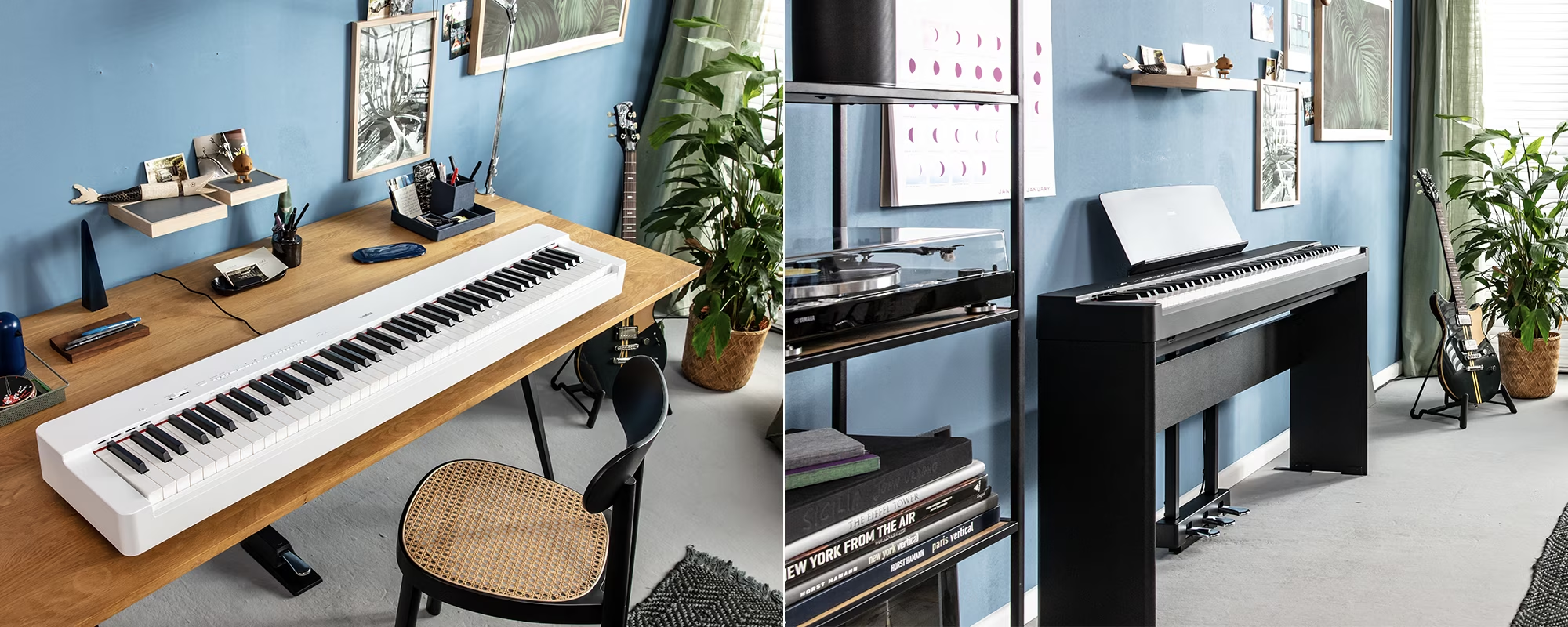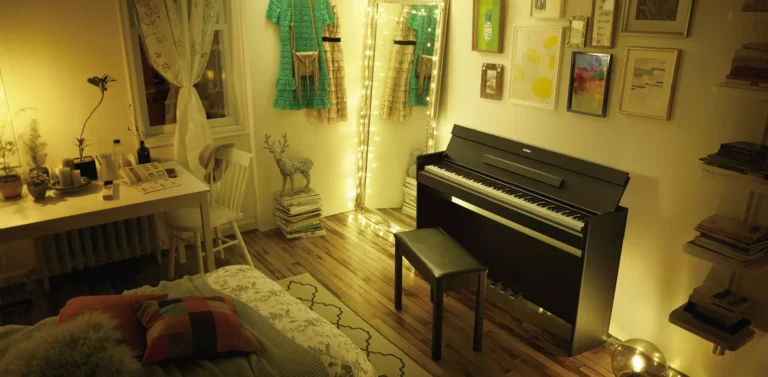
Today we have a digital piano showdown – the Roland FP-30 vs FP-30X. This article provides a professional review and comparison of the two models, where the FP-30X is the newer and updated model to the older Roland FP-30.
Roland FP-30 vs FP-30X Full Comparison: Best Digital Pianos
Contents
- Roland FP-30 vs FP-30X Full Comparison: Best Digital Pianos
- Roland FP-30 vs Fp-30X: FP-30X Key Features
- Roland FP-30 vs FP-30X: Roland FP Series Models
- Roland FP-30 vs. FP-30X: Which Is Better?
- Roland FP-30 vs. FP-30X: FP-30 Sound
- Roland FP-30 vs. FP-30X: FP-30X Connectivity
- Roland FP-30 vs FP-30X: FP-30X Controls
- Roland FP-30 vs FP-30X: Price
- Roland FP-30 vs FP-30X: Digital Piano Comparisons
- Roland FP-30 vs. FP-30X Conclusion
No products found.
Roland FP-30 vs Fp-30X: FP-30X Key Features
The FP-30X is the sweet spot of Roland’s FP-X series, striking a perfect balance of quality features and value for money. It builds on the entry-level FP-10 with an enhanced sound engine, more powerful onboard speakers, and increased polyphony.
An optional KSC-70 stand and KPD-70 three-pedal unit are available, for acoustic piano-realism and performance and traditional playing styles.
| Feature | Description |
|---|---|
| Sound Engine | SuperNATURAL Piano sound engine for realistic piano tones |
| Keyboard | 88 keys, PHA-4 Standard keyboard with escapement and Ivory Feel |
| Polyphony | 256-note polyphony for expressive and dynamic playing |
| Sounds | Wide variety of onboard sounds for every musical genre, including electric pianos, organs, strings, and synthesizers |
| Connectivity | USB, Bluetooth MIDI, and USB to device for versatile connectivity |
| Built-in Speakers | Powerful 22-watt stereo speaker system for room-filling sound |
| Headphone Output | 1/4-inch headphone output for private practice |
| Dual/Split Mode | Allows playing two different tones simultaneously or split the keyboard |
| Built-in Rhythms | Various built-in rhythms for added versatility |
| Metronome | Built-in metronome for practicing and timing control |
| Portable Design | Lightweight and compact design for easy portability |
| Piano Partner 2 App | Connects with the Piano Partner 2 app for interactive learning |
| Recording Function | Record and playback your performances for improvement |
| Transpose and Tuning Controls | Customize the pitch and tuning to suit your preferences |
| Auto Off Function | A rich selection of sounds including pianos, strings, and more |
Roland FP-30 vs FP-30X: Roland FP Series Models

Roland is known for their high-quality stage pianos, digital pianos, synthesizers, and other music gear. The FP series of digital pianos are excellent home practice instruments and make great stage pianos as well.
The entry-level Roland FP-10 is one of the best-selling and best-value digital pianos for musicians on a budget. You can read a full review of the FP-10 here:
The FP-30 builds on the FP-10 with better features, more sounds, better onboard speakers, and more. The Roland FP-30X is a more recent upgrade to the original FP-30, hence this review and comparison of the Roland FP-30 vs FP-30X!
It is worth noting that there are more premium models in the FP series including the FP-60 and FP-90. The FP-30X replaces the FP-30, which offers improvements over its predecessor.
Roland FP-30 vs. FP-30X: Which Is Better?

The FP30X is an improvement over the FP30, with 256-note polyphony versus the 128-note polyphony in the FP-30.
This is an important update as it allows the instrument to sustain more notes simultaneously, which is especially useful when layering sounds together.
This also means that the FP-30X can play more complex pieces with multiple layers of sound without cutting off notes.
Both the FP-30 and FP-30X utilize Roland’s SuperNATURAL sound engine to produce high-quality piano sounds.
However, the FP-30X has an improved piano tone with added string resonance, key-off resonance, and damper resonance, making the piano sound more authentic and expressive.
The FP-30X also has more modern and updated Bluetooth functionality, making it a great piano to learn on as a beginner, alongside the piano partner App 2.0 from Roland.
You can also connect it to a PC and use it as a MIDI controller to compose and record. There is also a mic input which is ideal for vocalists or duets.
It has the same 88 fully weighted keys and PHA-4 keybed and action, giving it a premium piano feel, and 5 types of touch sensitivity to refine your playing style. Here are some more features of the Roland FP-30X:
- Presets: 12 pianos, 20 electric pianos, 24 other tones = 56 presets
- Polyphony: 256-note polyphony
- Effects Types: Rotary, ambiance, modulation
- Playback: 30 internal songs
- Metronome: Yes
- Weight: 32.7 LBS with rest
- Speakers: 2 x 11W
- Colors: Available in black or white
Roland FP-30 vs. FP-30X: FP-30 Sound

Roland FP-30 vs FP-30X: The FP-30X sounds fantastic thanks to the SUpernatural sound engine, which delivers realistic and impressive piano, Rhodes, organs, and more.
Whilst not a huge difference over the previous model, the FP-30X does still deliver in the sound department, providing excellent sound across the board with all of its 56 presets.
If you need intimate pianos to practice at home, or silky Rhodes samples for live-function band performances, the FP-30X will not disappoint.
Though some may not be overly wowed by the downward-facing speakers, they do fit the bill for home practice but may take some getting used to.
They do offer room-filling sound if you practice in small spaces, but are not designed for performing in large rooms or to crowds.
You can always opt for headphones when practicing (which will always give you a better sound experience anyway) or plug the FP-30X into a piano amp or PA system. On that note, check out the best headphones for pianos here:
The Best Headphones for Practicing Piano
Roland FP-30 vs. FP-30X: FP-30X Connectivity

The FP-30 has the following connectivity features:
- USB: 1 x Type B, 1 x Type A
- Bluetooth & USB
- Bluetooth: v3.0 (audio), v4.0 (MIDI)
- Power Source: AC Power adapter
- Headphones: Yes, 1 x 1/8″, 1 x 1/4″
- Audio Outputs: 2 x 1/4″ (L/Mono, R)
As mentioned above, the FP-30X also has a mic input with a dedicated vocal reverb effect, which was not present on the FP30.
Roland FP-30 vs FP-30X: Another point goes to the FP-30X!
Roland FP-30 vs FP-30X: FP-30X Controls

The main point about the FP-30 X controls is that it is simple, intuitive, and easy to navigate. Finding the sound you want is only ever a button press away, and when it comes to digital and stage pianos, this is always a positive.
When you compare this to some other more complex and more expensive stage pianos, take the Nords for example, you will have to and spend several hours getting to know the instrument, reading the manual, occasionally agonizing over every minute detail if you are a perfectionist and finding your ideal sound and setup.
This is not the case with the Roland FP series of pianos, as the functionality is limited, and sometimes less choice is a good thing.
You have a button for your metronome, play, record, your standard category buttons, a power button, and that’s about it. There is very little clutter on the panel and beginners will get to grips with the instrument quickly.
The FP-30X has a slightly improved control panel over the older FP-30, with backlit buttons that are easier to read in low-light conditions. This is very useful for musicians who perform live.
You may occasionally have quite a dark stage setup where lighting is not always pointed directly at you, and that is when buttons that light up are extremely useful.
Roland FP-30 vs FP-30X: Price

The FP-30X is slightly more expensive than the FP-30, but the additional features and improvements justify the price difference.
Roland FP-30 vs FP-30X: Digital Piano Comparisons
Roland FP 30X vs FP 10

Both pianos showcase Roland’s commitment to high-quality pianos, and are excellent digital pianos in their own right, though the FP-10 is clearly aimed at being a beginner’s instrument with its limited sound set and functionality.
However, both pianos share the same PHA IV keybed, meaning the FP-10 can be used for intermediate players, for performances, and for teaching piano lessons effectively as well.
The FP-30X boasts advanced features for the discerning musician, while the FP-10 offers affordability without compromising on essentials.
Roland FP 30X vs FP 60X vs FP 90X

These three digital pianos represent different tiers in Roland’s esteemed lineup.
The FP-30X is perfect for those seeking fantastic quality and features on a budget, while the FP-60X caters to professionals desiring more advanced features and versatility.
One significant upgrade on each model is the increase in speaker size and the FP60X has dual 13-watt speakers that are 12cm x 8cm.
Meanwhile, the FP-90 showcases Roland’s flagship digital piano with a further improved speaker system (dual 25w speakers), and a better action too (PHA V action).
The dual 25w speakers naturally pack a punch in the FP-90X. and they work well as monitors onstage too. The PHA V action is made of a unique and innovative wood and plastic hybrid structure, with escapement.
The FP90X also showcases a larger sound set, with an impressive 20 piano tones, and a myriad of sounds in all other categories, far surpassing the other models.
Roland FP 30x vs Yamaha P125

Both pianos provide natural voices, but the Roland FP-30X stands out with its SuperNATURAL Sound Engine, giving it a more sophisticated sound. Additionally, the Roland FP-30X has more powerful speakers at 11W compared to Yamaha’s 7W.
The FP-30X has enhanced connectivity options and superior polyphony, as well as superior action according to many.
However, the Yamaha P125 remains a strong contender with its GHS action, and decent sound set, making the choice between them a closely contested one.
Roland FP 30x vs Kawai ES110

The Roland FP-30 and Kawai ES110 are both portable digital pianos priced under $1000, targeting beginner to advanced pianists. While both have compact designs, the FP-30 sports a more contemporary appearance.
In the sound department, the ES110 employs Harmonic Sampling with adjustable features like reverb and resonance, whereas the FP-30 utilizes the SuperNATURAL sound engine.
The Kawai ES110 is lighter in weight and is often recommended for classical music due to its action and piano samples.
On the other hand, the FP-30 offers a fuller sound with its superior hardware and features, and is arguably the better choice for jazz players, thanks to its impressive sound set and many high-quality Rhodes samples.
That is not to say that you cannot play classical music the Roland, and both pianos are solid instruments for pianists across all genres. Another feature that helps to edge the FP-30X out front, however, is its inbuilt audio interface.
Workstations

If you want something even more capable than the Roland FP-30X, then you may want to look into a workstation-style piano. Some excellent options to look into would be the Roland Fantom 8, Korg Nautilus, and Korg Kronos.
Workstations also make excellent stage and digital pianos and would be suitable for film composing as well as gigs, as you can compose and record directly on the instruments.
Check out the latest reviews of the Korg Kronos and Korg Nautilus Workstation Pianos below:
The Korg Nautilus Full Review – The Best Workstation?
Why the Korg Kronos is Still the Best Workstation
Roland FP-30 vs. FP-30X Conclusion
Overall, the FP-30X offers several improvements over the FP-30, including an improved piano tone, higher polyphony, more connectivity options, and an upgraded control panel.
However, the FP-30 remains a solid option for those on a budget who still want a high-quality digital piano with Roland’s SuperNATURAL sound engine. Ultimately, the choice between the two models will depend on the user’s specific needs and budget.



